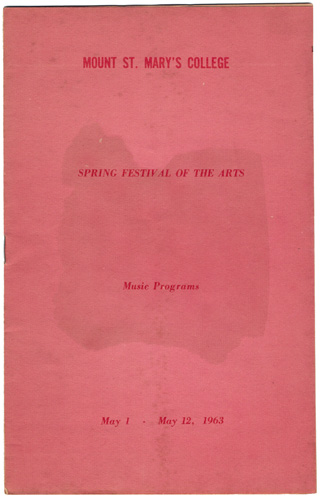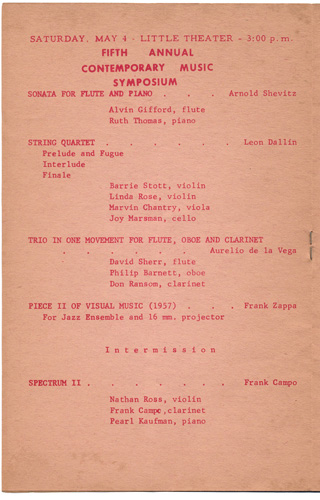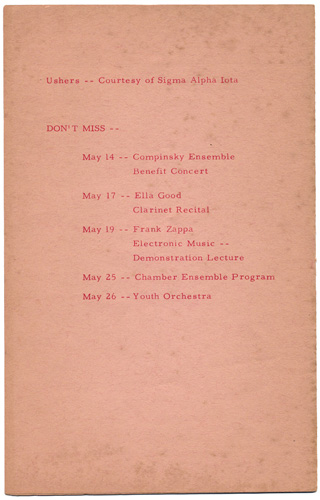The KPFK Recordings and Broadcasts
The event was recorded by KPFK [Los Angeles]. I think they've run [the tape] few times.
I became very fascinated with these early experiments of Frank Zappa and I recall that I brought to KPFK all of the tapes of that festival.
Well, KPFK in the early 60s was very much what you may call a sort of liberal establishment institution. Musically for example the only accepted music was classical, jazz, folkloric and a few well known electronic composers. Other kinds of music were not proper, you may say, and were seldom if ever played.
Well, those tapes I made in the festival that contained chamber, baroque or conventional classical music were played on prime time. But the tapes of Frank Zappa were shelved. Only after my constant requests, my constant pressure, finally but very grudgingly they agreed to play them. But it was aired in the worst time and with all of the comentaries deleted.
From an email, 6/26/2001 [...] On a shelf somewhere [Carlos Hagen has] got a recording he made on open reel in 1963 of a contemporary music festival held at Mount St. Mary's College above Santa Monica, where a young avant-garde composer named Frank Zappa had hired a pickup ensemble to perform some of his classical compositions for the very first time. [...]
July 1, 2001 [...] Discovered programs for Frank Zappa concerts at Mount St. Mary's college in 1963: Zappa performed one piece on May 4 as part of an afternoon concert, and then did a full concert of his own works on May 19. The May 4 concert was on the shelf right where it was supposed to be. The May 19 concert is still missing. [...]
From an email to "The Vaultmeister" at Barking Pumpkin Records, 2/10/2003 Glad the Mount St. Mary's package made it into your hands. Here's how I happened on the tapes: I work with the Firesign Theatre, and in 1999 I was at KPFK digging through their archive for old airchecks. I found a Radio Free Oz aircheck labeled "From the collection of Carlos Hagen." I figured he could be a resource for more Firesign, so I tracked him down. Carlos is a multidisciplined academic chap—a recording engineer, geographer, anthropologist, and documentarian. He was born in Chile in the late 1930s and he came to the U.S. to study geography in the Pacific Northwest. In the early 1960s he came to L.A. to work in the UCLA map library. He's always been a scholar of music and when he arrived he decided to preserve the local avant-garde music scene with the only means available to him: his own Ampex open reel deck, which he used to make audience recordings of many concerts including Zappa's concerts at Mount St. Mary's in May 1963.
Hagen joined the staff of KPFK around the same time. In the following decade he produced hundreds of hours of music documentary programs...
Charles Ulrich, August 10, 2013
Hagen produced the documentary in January 1974.
Known available sources
Apparently all available recordings come from KPFK broadcasts, though there are some edit differences. The Carlos Hagen 70s broadcast misses the last 5 seconds from Collage #1, at 3:25, available on the Drew ZRP Archives version at 1:49. Drew ZRP Archives misses 4 seconds from Opus 5 at 1:28, which are available on the Carlos Hagen 70s broadcast at 2:57. "Mount St. Mary's Concert Excerpt" from The Lost Episodes (1996) and "Opus 5" from We Are The Mothers And This Is What We Sound Like have 11 seconds of dialog at the end not available on the other versions.
| Drew ZRP Archives |
Carlos Hagen 70s broadcast |
WATMATIWWSL |
The Lost Episodes (1996) |
| |
(1. 00:00-12:59) |
|
|
| 1. 0:00-1:31 |
2. 0:00-1:32 |
|
|
| 2. 0:00-6:16 |
2. 1:32-7:43 |
|
|
| 3. 0:00-2:13 |
2. 7:43-9:54 |
|
|
| 4. 0:00-0:57 |
3. 0:00-0:55 |
|
|
| 5. 0:00-3:37 |
3. 0:55-4:29 |
|
|
| 6. 0:00-1:40 |
4. 0:00-1:38 |
|
|
| 7. 0:00-1:49 |
4. 1:38-3:25 |
|
|
| 7. 1:49-1:54 |
|
|
|
| 7. 1:54-2:11 |
4. 3:25-3:44 |
|
|
| 8. 0:00-1:52 |
5. 0:00-1:49 |
|
|
| 9. 0:00-3:55 |
5. 1:49-5:41 |
|
|
| 10. 0:00-1:32 |
6. 00:00-01:30 |
|
|
| 11. 00:00-00:23 |
6. 01:30-01:53 |
|
|
| 11. 00:23-00:34 |
6. 01:53-02:04 |
|
0:00-0:11 |
| 11. 00:34-01:28 |
6. 02:04-02:57 |
|
|
| |
6. 02:57-03:01 |
|
|
| 11. 01:28-01:48 |
6. 03:01-03:21 |
|
|
| 11. 01:48-03:02 |
6. 03:21-04:34 |
0:00-1:13 |
|
| 11. 03:02-04:27 |
6. 04:34-05:57 |
|
|
| 11. 04:27-04:33 |
6. 05:57-06:02 |
1:13-1:19 |
|
| 11. 04:33-05:36 |
6. 06:02-07:05 |
1:19-2:22 |
0:11-1:13 |
| 11. 05:36-11:59 |
6. 07:05-13:22 |
|
|
| 11. 11:59-12:47 |
6. 13:22-14:09 |
2:22-3:10 |
1:13-2:00 |
| 11. 12:47-12:50 |
6. 14:09-14:12 |
|
|
| 11. 12:50-12:55 |
6. 14:12-14:17 |
3:10-3:15 |
2:00-2:05 |
| 11. 12:55-13:20 |
6. 14:17-14:42 |
|
|
| 11. 13:20-13:33 |
6. 14:42-14:54 |
3:15-3:27 |
2:05-2:17 |
| 11. 13:33-13:47 |
6. 14:54-15:09 |
|
|
| |
|
3:27-3:40 |
2:17-2:28 |
| 12. 0:00-8:56 |
7. 0:00-8:52 |
|
|
| |
(8. 0:00-0:38) |
|
|
The Compositions Performed (And Their Names)
The compositions you will hear are, first, Piece #2 Of Visual Music (1957) For Jazz Ensemble And 16mm Projector, then, Piano Pieces From Opus #5, then, Collage #1 For String Instruments, then, Two Fragments Of The Prepared Tape To Be Used In Opus 5, and finally his then very controversial composition, Opus 5 For Piano, Tape Recorder And Multiple Orchestras.
Charles Ulrich, August 10, 2013
The first piece on the tape, "Piece II Of Visual Music (1957) for jazz ensemble and 16 mm. projector", together with FZ's explanations before and after, is from the first concert (May 4). The rest is from the second concert (May 19).
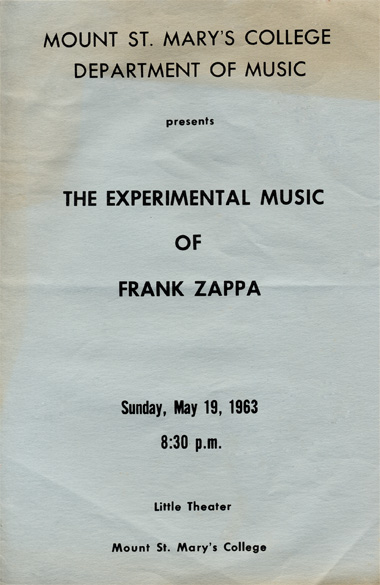
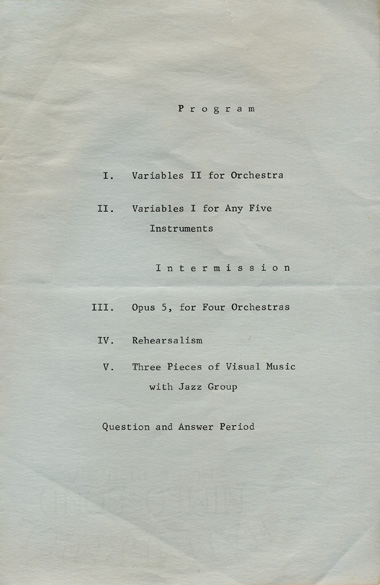
MOUNT ST. MARY'S COLLEGE
DEPARTMENT OF MUSIC
presents
THE EXPERIMENTAL MUSIC
OF
FRANK ZAPPA
Sunday, May 19, 1963
8:30 p.m.
Little Theater
Mount St. Mary's College
Program
I. Variables II for Orchestra
II. Variables I for Any Five Instruments
Intermission
III. Opus 5, for Four Orchestras
IV. Rehearsalism
V. Three Pieces of Visual Music with Jazz Group
Question and Answer Period
The next piece we're gonna perform, instead of Variables I For Any Five Instruments, will be a group of piano pieces taken from the Opus 5 For Four Orchestras.
[...] The next piece we're going to perform will be Collage 1 For A String Group Accompanied With Woodwinds.
[...] The next piece that we're going to play [is] called The Collage 2, and it was written last Thursday.
The Money
In fact I did pay once to hear my music played a long time ago. I scraped up about $300 to put on a concert at Mount St. Mary's College. It was a student group. I had to pay those damn kids to rehearse the music. They hated my stuff. But I didn't do any of that with the prospect of making money.
Actually, the first time I had any of [my "serious" music] performed was at Mount St. Mary's College in 1962.
I spent $300 and got together a college orchestra, and I put on this little concert. Maybe less than a hundred people showed up for it, but the thing was actually taped and broadcast by KPFK. Last year a guy in England, who somehow got a copy, sent me a cassette of it, but I haven't bothered to listen to it.
[...] By the time I graduated from high school in '58, I still hadn't written any rock and roll songs, although I had a little rock and roll band in my senior year. I didn't write any rock and roll stuff until I was in my 20s. All the music writing that I was doing was either chamber music or orchestral, and none of it ever got played until this concert at Mount St. Mary's.
It was all oddball, textured weirdo stuff.
In fact, this concert even involved sounds on tape. I was doing tape editing of electronic music, and part of all the pieces had this little cheesoid Wollensak tape recorder in the background pumping out through mono speakers—sounds that were supposed to blend with the acoustic instruments. And there were sections of improvisation and a lot of different experimental techniques.
By that time, I had already heard Stockhausen. I had already heard Boulez.
Mount St. Mary's was the first time I had a concert of my music. As with most of the other concerts of my music, I had to pay for it.
That was 1962. That was a bargain, though, because it was only $300. It was a student orchestra. There were probably about fifty people in the audience, and—for some strange reason—KPFK taped it, and I got a copy.
There was one thing called "Opus 5," and there were aleatoric compositions that involved a certain amount of improvisation, and there were some written sections that you actually had to play. Some of the things were graphic, and there was a tape of some electronic music that was being played in the background with orchestra, and I had some 8mm films that were being projected.
DS: What can you tell us about the [Mount St.] Mary's College [in Claremont, California] performance of tapes and stuff that you did?
FZ: Well, I can tell you that it was the first time that I was forced to spend my own money to hear my music performed. That concert cost me three hundred dollars. Three hundred 1962 dollars, which was a lot of money then.
DS: Yeah.
FZ: The event was recorded by KPFK [Los Angeles]. I think they've run [the tape] few times.
DS: How many people attended that?
FZ: Maybe . . . two hundred.
DS: It was, like, a college type thing.
FZ: Yeah, it was a small college auditorium thing.
DS: D'you have any remembrances of what their reaction to it was?
FZ: A combination of amusement and bafflement, (laughter) which was totally appropriate.
The Musicians
FZ, KPFT-FM Houston, October 11, 1975
There were some people who were in that orchestra that I've used on other albums where I used orchestral musicians. Appeared on Lumpy Gravy, a few of 'em. And I still keep in touch with 'em.
Dr. Matt Doran
Frank's appearance with Steve Allen also got the attention of Dr. Matt [Doran], music professor at Mount St. Mary's College. Dr. [Doran] thought it would be a good idea to bring Frank Zappa in to demonstrate new methods of creating music to the students. [...] One of the nuns that had to be convinced was Sister Maura Jean, who still shakes her head when she thinks of the event!
Matt Doran has composed 220 works. They include ten operas, six symphonies, six concerti, various songs, choral compositions, chamber pieces, and 70 works that involve the flute. [...] An interesting sidelight is that he gave Frank Zappa his first concert at Mount St. Mary's College! At present he continues to compose and give piano, magic and flute lessons privately in Vancouver.
Charles Ulrich, November 20, 2013
[Matt Doran] said that FZ called him on the phone, wanting him to facilitate a concert.
Dr. Doran had not seen FZ on The Steve Allen Show. In fact, he said that the TV appearance was after the Mount St. Mary's concert. (But he still didn't see it. FZ called him afterwards and told him he had been on television.)
He said that he himself put together the ensemble for the concert. He thinks he got students from UCLA (MSMC not having many students). He knows who Joseph Wagner was, but said that Wagner had nothing to do with the concert.
Barry Brisk was the only participant he could name. When I listed the three musicians I know of, he remembered Philip Barnett, but not Peter Arcaro. (It figures he'd remember the woodwind player.)
He mentioned that at the concert FZ "did a thing with rocking chairs that was just too crazy to talk about."
Matt Doran, as told to his son, Charles Doran, c. 1990s
On May 19, 1963, the Mount Presented the "Experimental Music" of Frank Zappa. It so happened that in early Spring of that year I answered the phone and a voice announced "My name is Frank Zappa; I am 22 years old and it is time that I gave a concert." I don't know how he got my phone number but I was impressed by this direct approach and arranged to meet him, right in front of the home of Mariblanca de Pujabas, a former student. There I met Frank and his father who had to do the driving. Frank was not allowed to drive because his license had been revoked in connection with the production of porno films. He told me he needed three groups of musicians, brass, strings and woodwinds plus three conductors for a concert of his experimental music. His father gave me a check for one hundred dollars. I contacted players from UCLA, secured the Little Theatre at the Mount. The concert was set for May 19th, 1963 at 3:30 pm.
Sr. Maura Jean was pro-tem chairman of music at the time—Sr. Miriam Joseph was on sabbatical. Maura Jean had heard rumors about Zappa and got extra security. But it turned out not to be necessary. The Zappa experimental music included 3 groups of players, each with its own conductor—Barry Brisk was one. So the audience saw a string group, one for brass and one for woodwinds. Zappa was the overall conductor. The instructions given to the performers were to play anything they wanted—exercises, fragments from symphonies, notes made up on the spot, etc.
Zappa would point to the woodwind group, for example, then cut them off and point to strings, etc. The conductor of each group would signal the musicians to play. There could be 3 groups, 2 or 1. The audience began to laugh; so did the players, so did Zappa who mercifully stopped the proceedings, turned to the audience and bowed. There were boos, applause, snorts and angry words. Nothing seemed to bother Zappa—just as nothing seemed to bother John Cage in HIS musical experiments (from which, possibly, Zappa borrowed).
Then came a really strange bit of (monkey) business. Zappa had taken a movie camera and turned it up and down, sideways, in circles, etc., and made a film of about 7 minutes. This was shown against a screen and the players were again asked to play anything, improvise, etc. This was received with even more contempt than the other piece. But Zappa was in his glory. He had put on his first concert, created some sort of impression and made his start. But I and others considered him a fake, an imposter, a charlatan.
A few days later Zappa phoned and told me he was to appear on the Steve Allen Westinghouse TV program. I was amazed to hear this, of course. He asked me to watch. I did not because I considered him to be a fake. This was chicanery to the 9th degree.
The next day Zappa phoned. I told him I had not watched. He was not dismayed and told me he had played music by blowing through bicycle handle bars! This convinced me he belonged to vaudeville more than to the world of music.
And yet, when we had the next symposium, I let him put on his "composition" for players. The other composers were disgusted and angry. They asserted that Zappa was a charlatan and should not be on a program of musical compositions. Some, of course, were angry at me for including him. I had a hunch there might be more to Zappa than these witless experiments.
I did not know at the time that he was an expert guitar player and would form a group known as "The Mothers of Invention". I heard reports about his rock-style-concert success in the Pop musical world. He had a commission to compose a piece for the L.A. Philharmonic combined with his "Mothers." In time I heard him referred to as America's most original composer! He formed a company, made recordings, had 3 musical children and with his daughter Moon Unit, wrote a valley girl song, entered politics, etc.
He didn't forget me and years later sent 2 tickets to a concert at Pauley Pavilion at UCLA. I attended this concert with a student, Rick Henn, who had written songs for the Beach Boys. Peter Korn was also there.
The concert opened with the L. A. Philharmonic and Zubin Mehta. They did something by Stravinsky. Then the second half began. Zappa entered, gave the audience the finger, told a dirty story about an old man and cookies, said he was sorry the piano player was missing but would start his part of the concert anyway! I thought to myself: Would a string quartet begin without the viola? Apparently it made little difference. There were enough guitars and percussion to fill Pauley. The pianist showed up but it didn't seem to add or detract.
Years later Moon Unit appeared on Howard Stern's show. Howard was asking the usual questions regarding her sex life when the phone rang. It was Zappa, possibly concerned about Howard's line of questions. Then, they began talking about Zappa's prostate cancer. Howard said he heard it was getting better. Zappa replied he had not heard such positive words from his doctors.
Zappa died a short time later at the age of 52! Much too soon.
I went to a music store a few years ago and picked up some Zappa CDs—"Shut up and Play Yer Guitar" etc. I found there were Zappa clubs, a place to get info about him. I wrote to a Zappa center and asked if they would like to hear about his first concert at Mt. St. Mary's College. I received no reply and that is the end of Zappa and Doran!
Charles Doran, April 25, 2021
I just hope some people don't misinterpret what [my dad] wrote. He really was quite impressed by Zappa. I recall going to a sheet music store in Hollywood and my dad showed me some of Zappa's compositions, explaining to me how complex his work was.
The Conductors: Peter Arcaro and Barry Brisk
I'm conducting the tape recorder, the strings and the piano, and Barry is conducting the woodwinds, and— What's your name? Pete is conducting the brass.
Charles Ulrich, August 4, 2013
Two of the composers were Mount students; Barry Brisk and Victor Sleinhardt.
That must be the third conductor of Opus 5! Peter Arcaro told me that Barry (whose surname he couldn't remember) was a conducting student and thus really knew how to conduct.
Charles Ulrich, August 8, 2013
Barry Brisk confirms that he was the conductor and that the all-FZ concert was not part of the symposium. He said that the audience was thirty people at the most. He couldn't remember any more of the musicians.
Malcolm McNab, Trumpet
Malcolm McNab, Wazoo (Vaulternative Records, 2007), liner notes
In 1963 I performed in a concert at Mount Saint Mary's College in Brentwood where he performed a piece, supervising several sub-conductors and fronting the ensemble with an amplified zither played with a soup spoon.
I first met Frank Zappa at Mount Saint Mary's College in Brentwood on May 4, 1963 He was studying in the music department and one of his teachers was composer Matt Doran. In a program at the Little Theater at Mt Saint Mary's, Frank wrote a piece for orchestra with multiple conductors. Very free and avant garde with Frank fronting the orchestra with an amplified zither played with a soup spoon. There had been a reception earlier in an adjacent room and on the table were some decorative plastic trumpets. Frank insisted that we play them during the concert. Also he was very excited about having the English horn player suck through the bell of his instrument, creating quite a unique sound.
Philip Barnett, Oboe
Malcolm McNab, in correspondence with Charles Ulrich, February 27, 2008
About the Mt St. Mary's concert—I was playing in the college-community orchestra part time and I can only remember 2 other musicians, both friends of mine and students at MSM. Peter Arcaro, trumpet and Philip Barnett, oboe & english horn. There were multiple conductors and the musicians were encouraged to get other sounds out of their instruments by any means possible. Front and center was Frank, playing an amplified zither with a soup spoon, in a solo role. I really can't remember who else was in the orchestra. I guess it was a student orchestra.
Don Christlieb?
APPLIED MUSIC FACULTY
[...] Bassoon—Don Christlieb, Ralph Lee
Lucy Shelton, Flute?
David Scott, on personal correspondence with Charles Ulrich
Lucy Shelton [Pomona student who graduated in 1965, now a professional soprano] told me that she played flute on something that Frank recorded in Little Bridges; he was up in the balcony directing things. Lucy recalls, "We had little scraps of paper with notes on them in front of us. Frank called down, 'I want you to improvise. We're kind of in the key of E, but don't play any Es.'" Lucy also performed with Frank in the late 1970s or early 1980s [4/17/81 Varèse tribute in New York].
Dr. Pattee Evanson
I got a call from Manuel Compinsky asking me to audition for a scholarship to Mt. St. Mary's College. My flute teacher, George Drexler (principal in the LA Phil.), had recommended me, apparently more impressed by my capacity for work than any talent. Translation: I was a pretty raw beginner. I got to the audition to find Mr. Compinsky, Sister Maura Jean (the outgoing chair of the music department) and a huge guy with a nice smile, Pattee Evanson—Dr. Evanson, although the degree hadn't yet been completed. Sister Maura Jean had been a student of Arnold Schoenberg and a classmate of Leonard Stein at UCLA. She taught electronic music among other subjects. Evanson took command and had me play a few orchestral excerpts. It wasn't going too well when Compinsky stepped in. He asked me to play a low c "as softly as possible." That's pretty much the only way a beginner can play a low c. I did it and he said, "fantastic control." I never found out if that was some sort of put-on. Evanson said, "young man, we want to invest in you" and I was offered a scholarship.
Evanson's nice smile didn't last. The guy was a lunatic [...] He was probably the worst teacher I have ever had but he did do two things (and only two) right. One was to bring to our music history class a guest lecturer, one Murray Shapinski, who wove fascinating tales of his long career in music and claimed that Bartok had written a solo sonata for him. (Others have disputed this claim and there is no mention of it in any document I can find.) He played his bass for us and actually sounded quite good. [...]
Evanson's only other positive accomplishment was to bring to the same class a clean-cut young man in a checkered blazer and a snappy bow tie (I'm not making this up), name of Frank Zappa. He introduced him as a composer and turned the class over to him.
Frank had managed to get permission to use the school auditorium for a concert and was trying to recruit musicians. He described his music and it sounded pretty far-out: flutists playing just the head joint (the top part of the flute, before you get to the keys), other unconventional techniques, random improvisation, etc. Someone asked him why.
"Because I think that's the way music should be," he said.
"What about Brahms and Schubert?" someone wondered.
"They're part of the evolution of music. I'm the culmination," he answered.
The combination of the pompous Evanson ("upon whom the shoe fits, let it be worn," he used to say) and the iconoclastic Zappa was a pretty weird one and I never found out how it came about. The way he described the concert it sounded as if it might have been fun but I had an exam that night and had already missed a class session because of a gig. I could hear it faintly while we took the test but it ended around the same time as the class.
Anybody else?
Don Preston, January 28, 2002
I have never heard that Zappa used tapes and film projections with that concert. What I remember is that he wrote a score for 4 orchestras to be performed at the same time using 4 conductors in that concert. I was not involved in that concert.
